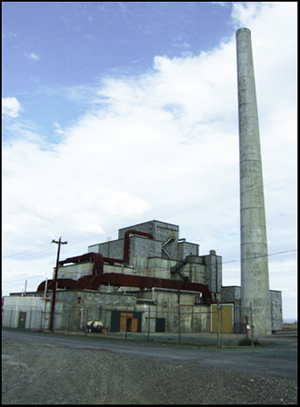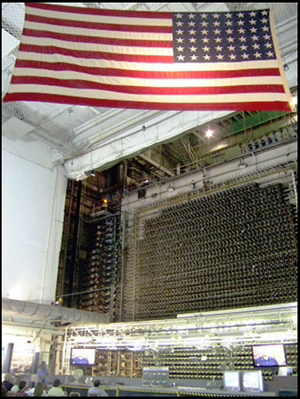|
Special Reports Sitting inside an old nuclear reactor, gazing up at a wall that holds over 2,000 cylinder rods that once produced plutonium for our nation�s atom bombs. That�s how I spent my Labor Day weekend. Located just outside of Richland, in eastern Washington State, the Hanford Nuclear Reservation spans 586 square miles on high desert plains. The mighty Columbia River marks the site�s eastern boundary where its waters once served as the depository for a few of the reactors� contaminated effluent. Belly-high barbwire fencing, with phallic smoke stacks positioned next to its aging boxy structures, surrounds Hanford�s dry austere landscape. The aura of this rough terrain, taken from the Wanapum tribe only 66 years ago, is evocative to say the least. By all accounts the B Reactor is historic. For starters, it�s the most polluted nuclear site on the planet. �It was the perfect marriage of science and engineering,� one of our guides expressed almost tearfully. �The brave men that built this left us a history we should not ever forget.� I certainly agree we ought not disregard the B Reactor�s true legacy. Beyond the lofty rhetoric of scientific achievements and marvelous engineering feats lives a story our government would rather not recall. It�s a tale of death and environmental destruction, the remnants of which are with us to this day. Perhaps most significantly, the plutonium produced in B was used as fuel for the �Fat Man� bomb that was dropped on Nagasaki, Japan, on August 9, 1945, at the behest of President Truman. While educational video rolled, explaining this fact to reactor tourists, the scenes that followed were not of the devastation the bomb had on these innocent Japanese. Over 80,000 men, women and children eventually died as a result of that brutal bombing. Bodies were broiled with radiation, maimed and so badly charred that friends and family were only left with unrecognizable skeletal fragments to remember their loved ones by. Yet, not one photograph of this was on display in any of the documentary footage shown on the big television screens at B. Instead, we were simply told that �six days later the war ended.� Hallelujah and pass the Kool-Aid. Of course, it was not Truman�s nuclear bombings that ended the war and crushed the morale of the Japanese. In 1944, the War Department set up the United States Strategic Bombing Survey, which focused its efforts on interviewing the civilian and military leaders in Japan shortly after they surrendered. As the report noted, �Based on a detailed investigation of all the facts and supported by the testimony of the surviving Japanese leaders involved, it is the Survey�s opinion that certainly prior to 31 December 1945, and in all probability prior to 1 November 1945, Japan would have surrendered even if the atomic bombs had not been dropped, even if Russia had not entered the war, and even if no invasion had been planned or contemplated.� President Truman and others most certainly knew this prior to the bombings of Hiroshima and Nagasaki. American intel had infiltrated and broken Japanese code and the Japanese military knew they were being intercepted by our military forces. Over in Moscow, as early as June 1945, the Japanese ambassador there was already working on a peace agreement with the Allies. Discussions of a Japanese surrender were noted a full year before Truman dropped the first atom bomb on Hiroshima. But history from our government�s point of view rarely reveals the truth behind its military exploits or, in this case, its mass murder. If one were to only watch the video screens and listen to the guides on the B Reactor tour, they would walk away with a distorted and glorified perception of our deleterious nuclear era. Aside from the Japanese death toll, back home the environmental impact of Hanford is also not represented in the glossy flyers handed out to visitors after the tour comes to an end. The Columbia River, which maintains the country�s most productive salmon fishery and provides irrigation water for tens of thousands of Northwest farmers, was for over two decades polluted with radioactive runoff from B. As historian Michelle Gerber writes in On the Home Front: The Cold War Legacy of the Hanford Nuclear Site, �In 1959, Hanford biologists reported that the number of chinook salmon spawning in the vicinity was only about 19 percent of 1958.� Gerber adds that nearby towns along the Columbia were also affected, �In mid-1947, river water at Pasco and sanitary (city) water at Kennewick first showed detectable levels of gross beta-emitting radiation . . . Values in the river water at Richland were even higher, reaching up to four times that at Pasco by late 1948.� Studies to this day are seeking to unravel the extent to which the Columbia River is being contaminated by several of Hanford�s slow-leaking radioactive tanks, which are at the heart of the largest environmental cleanup this country has ever undertaken. Interestingly enough, Michelle Gerber, now an in-house historian for Fluor Hanford, was trailing along behind our tour group, jotting down notes and chiming in on occasion. It�s too bad her knowledge of the environmental consequences of Hanford were not shared with all visitors that day. Perhaps Fluor now pays her to perform other mundane tasks. It wasn�t just the Columbia River that Hanford�s reactors filled with radioactive toxins, so too was the air in the region. Smoke stacks, built 200 feet high, were meant to release the reactor�s toxic debris when winds were strongest as to not contaminate the facility workers below. However, when production of plutonium reached its peak during the Cold War, plant operators were forced to ignore the wind patterns and released toxic debris into the air throughout the day. Only two years into operation, radioactivity levels at two testing sites, as well as the nearby cities of Richland, Pasco, Kennewick and Benton City, all exceeded acceptable levels of radioactive contamination. At certain periods, such as the December, 1949 �Green Run,� where raw uranium fuel slugs were being processed, winter storm events hit the region, causing heavy deposits of radioiodine (I-131) and Xenon (Xe-133) to literally rain down on local communities. Samples taken during the �Green Run� incident were one thousand times the government�s recommended level. Towns as far as away as 70 miles, such as Walla Walla, Washington, even registered high readings. The product produced inside the B Reactor helped to kill countless people and the poisoning of the land, air and water from this one facility alone outshines the catastrophe of Three Mile Island. Yet none of our guides on the tour shared any of this with us that day. It is a travesty too. If we do not learn from our history, no matter how awful and unsavory it may be, we are apt to repeat it. Joshua Frank is the author of �Left Out! How Liberals Helped Reelect George W. Bush� (Common Courage Press, 2005), and, along with Jeffrey St. Clair, the editor of �Red State Rebels: Tales of Grassroots Resistance in the Heartland,� published by AK Press in July 2008.Copyright © 1998-2007 Online Journal Email Online Journal Editor |

